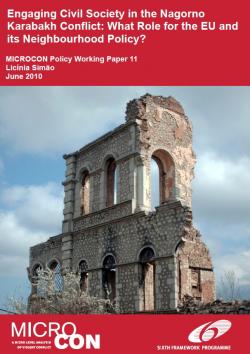Engaging Civil Society in the Nagorno Karabakh Conflict: What Role for the EU and its Neighbourhood Policy?
The conflict over Nagorno Karabakh, opposing Armenia and Azerbaijan, is the longest conflict in the OSCE area and a fundamental security threat to the South Caucasus and surrounding regions, preventing full and inclusive economic development and constraining regional relations. This chapter takes the ENP as a conflict transformation tool and looks at how the EU has used this initiative to reach civil society organisations (CSOs) and improve their performance as peace-builders in this protracted conflict. Building on the theoretical framework presented by Tocci (2008), the chapter assesses EU involvement in the civil society domain, mapping the types of organisations privileged by the EU and the potential impact of their activities on the conflict. It puts forward relevant arguments regarding the suitability of the EU’s goals and instruments to the dynamics on the ground and concludes with a categorisation of the EU’s approach according to three hypotheses: The Liberal Peace, the Leftist Critique and the Realist hypothesis. It is argues that work with civil society is a crucial part of the EU’s approach, despite the difficulties of making such engagement a central part of its peace-building and conflict transformation activities.
Paper produced in the context of the MICROCON project (Work Package 11, "Conflict in the European Neighbourhood"), funded by the EU's Seventh Framework Research Programme. Subsequent versions: "Are Civil Society Organizations the Missing Link? Assessing EU Engagement in the Nagorno-Karabakh Conflict", in Nathalie Tocci (ed.), The European Union, Civil Society and Conflict, London and New York, Routledge, 2011, p. 50-74 (Routledge/UACES contemporary European studies ; 19)
-
Details
Brighton, Institute of Development Studies at the University of Sussex, June 2010, 37 p. (MICROCON Policy Working Paper ; 11) -
ISBN/ISSN/DOI:
978-1-85864-935-8
Introduction
1. Conflict Dynamics
1.1. Addressing Mutual Perceptions
1.2. Human Dynamics
1.3. Political Dynamics
2. EU engagement with civil society in conflict resolution
2.1. Financial Instruments
2.2. Regional initiatives
2.3. Conflict prevention and crisis management
2.4. Overview
3. Civil society working on conflict resolution in Armenia, Azerbaijan and Nagorno Karabakh
3.1. Types of Activities
3.2. CSO Impact
3.3. CSO Effectiveness
4. EU impact
5. Explaining EU activities in the civil society domain
References
Topic
Tag
Related content
-
Publication12/02/2015
The European Union, Civil Society and Conflict
leggi tutto -
Ricerca27/01/2014
MICROCON - Conflicts in the European Neighbourhood
leggi tutto



